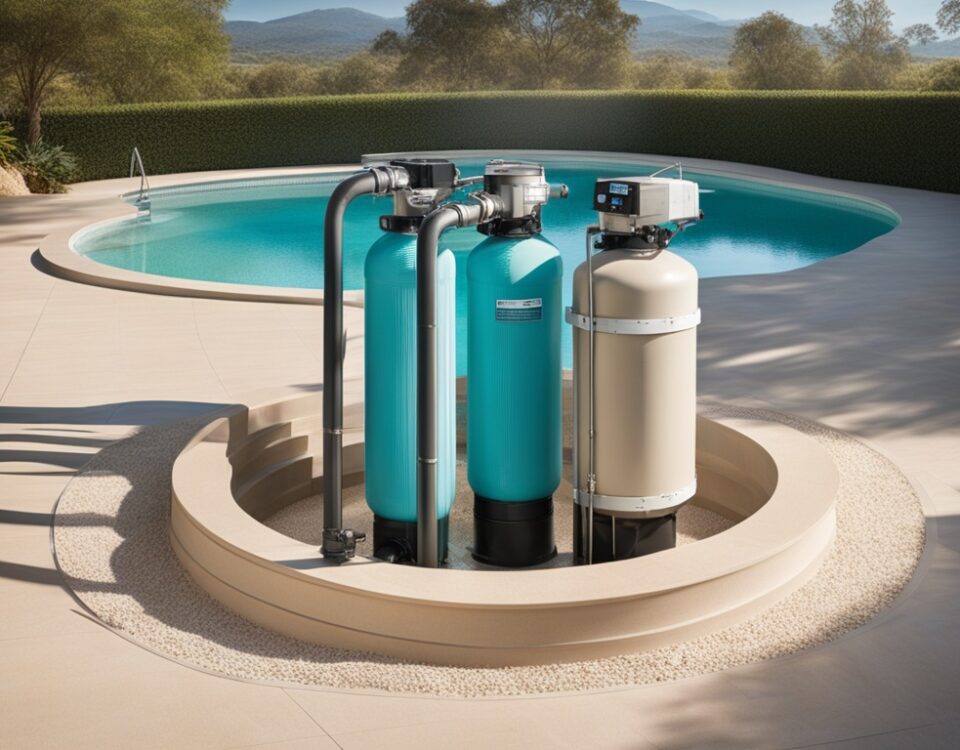Suction Cleaner or Pool Skimmer: Which Reigns Supreme for Sparkling Pools?

Splendid Poolside Furniture Inspirations for Your Outdoor Oasis
May 7, 2025
Unveiling the Magic: Demystifying How a Saltwater Chlorinator Works
May 7, 2025Exploring Pool Maintenance Essentials
Maintaining a clean and safe swimming pool is critical for ensuring an enjoyable and healthy swimming experience. Regular upkeep not only enhances the aesthetic appeal of your pool but also prevents potential hazards such as algae growth, bacteria build-up, and equipment malfunction. A well-maintained pool can significantly prolong the lifespan of the swimming pool infrastructure, ultimately saving you time and capital in the long run.
One of the foremost reasons to prioritize pool cleanliness is the health implications associated with stagnant water. Bacteria, germs, and allergens can proliferate in a poorly maintained pool, posing risks to swimmers, especially children and individuals with compromised immune systems. Furthermore, neglecting pool maintenance can lead to costly repairs down the line, making it essential for pool owners to adopt a comprehensive cleaning strategy from the outset.
Among the myriad of tools and techniques employed in pool cleaning, two standout players emerge: the pool skimmer and the suction cleaner. Though both serve the pivotal purpose of keeping your pool pristine, their methodologies and effectiveness are distinct, warranting a nuanced understanding as to which tool is best suited for your specific needs.
Understanding the Pool Skimmer
The pool skimmer is a manual or automatic device adept at removing debris from the surface of the water. Typically designed as a floating or mounted apparatus, skimmers efficiently capture leaves, insects, and other floatables before they settle to the pool floor. *One of the primary advantages of a skimmer is its capacity for immediate removal of surface contaminants, ensuring that your pool remains visually appealing and minimizing the amount of debris that enters the filtration system.*
Exploring the Suction Cleaner
In contrast, the suction cleaner operates on a more intricate principle. Utilizing the suction created by a pool’s filtration system, this device autonomously navigates the bottom and sides of the pool, sucking up dirt, sand, and debris that may have settled. *With the versatility to cover varying pool shapes and surfaces, suction cleaners are effective for deeper cleans, making them indispensable for maintaining water clarity and hygiene.* However, proper setup and understanding of the cleaner’s operational dynamics are necessary to maximize its effectiveness.
| Feature | Pool Skimmer | Suction Cleaner |
|---|---|---|
| Primary Function | Removes surface debris | Cleans pool floor and walls |
| Operation Method | Manual or automatic | Uses suction from filtration |
| Debris Types | Leaves, insects, surface dirt | Sediment, algae, and debris |
| Ease of Use | Simple operation | Requires understanding of setup |
Understanding the Role of a Pool Skimmer
How a Pool Skimmer Works
A pool skimmer serves as an essential component in maintaining pristine water quality in your swimming pool. Functioning as a suction device, it actively removes debris such as leaves, insects, and dirt from the water’s surface. The mechanism operates by drawing in water from the pool’s surface through a specialized collecting basket, effectively filtering out these impurities. The extracted debris then accumulates in the skimmer’s basket, which must be regularly emptied to maintain optimal efficiency. Without this crucial operation, floating debris can decompose, leading to unsightly stains and algae growth.
Manually Using a Pool Skimmer
While many modern pools are equipped with automatic skimmers, the manual pool skimmer is a simple yet effective tool for keeping your pool free of debris. To manually use a pool skimmer, one must first attach the long pole to the skimmer net. Next, the skimmer net should be submerged just below the water’s surface, gently gliding across the pool to collect floating debris. When the net fills with leaves or other unwanted particles, it is crucial to lift it out of the water gradually to prevent the contents from spilling back into the pool. Disposing of the debris can be done easily by emptying the net into a trash bag or composting it, depending on the type of waste.
Benefits of Using a Pool Skimmer
The advantages of utilizing a pool skimmer as part of your maintenance routine cannot be overstated. First and foremost, it helps to *maintain water clarity* and prevents buildup that could lead to algae and bacteria. Regular skimming contributes to reducing chemical usage, as the less clutter in your pool, the fewer chemicals are needed to maintain clear, beautiful water. Moreover, the skimmer’s capability to catch larger debris prevents further clogging of filters and pumps, ultimately extending the lifespan of your pool’s equipment.
Limitations of Using a Pool Skimmer
Despite its many benefits, relying solely on a pool skimmer has its limitations. One significant drawback is that a skimmer primarily addresses surface debris; it does not effectively remove particles that have sunk to the bottom of the pool. This limitation necessitates the use of additional cleaning tools such as suction cleaners or automatic pool vacuums for complete pool maintenance. Furthermore, manual skimming can be tedious and time-consuming, especially during peak seasons when leaves and debris are abundant. This reinforces the idea that a multifaceted cleaning approach is often the most effective for comprehensive pool care.
Comparative Overview
| Criteria | Pool Skimmer | Suction Cleaner |
|---|---|---|
| Debris Collection | Surface debris only | Bottom and surface debris |
| Ease of Use | Manual operation | Automatic operation |
| Maintenance Needs | Frequent basket emptying | Occasional filter cleaning |
| Cost | Generally lower | Higher initial investment |
Conclusion
Overall, the pool skimmer remains a vital apparatus in the realm of pool maintenance. It is essential for preserving water quality and prolonging the efficient operation of pool systems. However, understanding its limitations and the complementary features of other cleaning devices is crucial for achieving a truly *spotless swimming pool environment*.
Delving into the Functionality of a Suction Cleaner
A suction cleaner, often touted as the unsung hero of pool maintenance, operates on a fundamental principle: the vacuum effect. These devices are designed to leverage the existing pool filtration system, effectively utilizing suction to remove dirt, debris, and other contaminants from the pool floor and walls. With the connection to a skimmer or filtration system, the suction cleaner navigates the pool autonomously, gliding over surfaces to collect debris in its filtration bag or send it into the pool’s filtration system. This process not only cleans the pool but also circulates the water, ensuring a more homogeneous chemical balance and temperature throughout the swimming area.
Efficiency in Debris Removal
When comparing the efficiency of suction cleaners to pool skimmers, it is essential to understand their distinct roles. A pool skimmer primarily collects floating debris, such as leaves and insects, that accumulate on the surface of the water. While it serves its purpose well, it does not tackle sediments or larger debris settled on the pool floor. In contrast, a suction cleaner excels in this domain, effectively removing both floating and sunk debris, thereby ensuring a more comprehensive cleaning solution. It is not uncommon for a suction cleaner to achieve a cleaner pool bottom than a skimmer can manage alone, often working in tandem with the skimmer for optimal results.
Advantages of Using a Suction Cleaner
One of the primary advantages of employing a suction cleaner is its *autonomous functionality*. Many models are designed to operate independently, requiring minimal human intervention and allowing pool owners to focus on leisure rather than labor. Additionally, suction cleaners are generally more efficient in reaching corners, steps, and walls, where debris often accumulates but skimmers cannot reach effectively. The overall time savings from using a suction cleaner can reduce the frequency of manual cleaning and prolong the life of the pool’s water by enhancing filtration.
Disadvantages of Using a Suction Cleaner
Despite their many benefits, suction cleaners come with their own set of drawbacks. *One notable disadvantage is their dependency on the pool’s filtration system*; if the system is not operating correctly or becomes clogged, the efficiency of the suction cleaner diminishes significantly. Furthermore, certain models may struggle with larger debris, making it necessary to pre-clean the pool of substantial items like branches or toys. Lastly, some users report challenges with the suction cleaner getting stuck in particular areas, requiring occasional manual intervention to untangle or reset the device.
Performance Metrics and Comparisons
| Feature | Suction Cleaner | Pool Skimmer |
|---|---|---|
| Debris Collection | Floats & Sinks | Primarily Floats |
| Autonomy | High | Limited |
| Maintenance Required | Low | Moderate |
| Efficiency on Pool Floor | High | Low |
In conclusion, the functionality of a suction cleaner positions it as a vital component in effective pool maintenance. By understanding its operational mechanisms, comparative efficiencies, and inherent advantages and disadvantages, pool owners can make informed decisions on how best to maintain their aquatic oasis, ensuring a pristine swimming environment year-round.
Factors to Consider When Choosing Between a Pool Skimmer and Suction Cleaner
Cost Comparison
When considering a pool skimmer versus a suction cleaner, cost plays a pivotal role. Skimmers generally come with a lower initial investment, usually ranging from $100 to $500, depending on the model and brand. They are often installed within the pool’s structure and require minimal additional equipment. In contrast, suction cleaners can range from $150 to $800 or more, factoring in both the cleaner itself and any necessary accessories like hoses or connectors. While suction cleaners may entail a higher upfront cost, they can provide comprehensive cleaning for larger debris and stubborn dirt.
Maintenance Requirements
Both pool skimmers and suction cleaners come with their own sets of maintenance needs. Skimmers typically require regular manual cleaning, where debris collected in the skimmer basket must be emptied frequently to maintain efficiency. However, they are relatively low-maintenance in terms of mechanical parts. Suction cleaners, on the other hand, may require more frequent upkeep due to their moving parts and hoses, which can become tangled or clogged. Moreover, users must monitor their filter systems more closely, as suction cleaners may demand more cleaning cycles compared to skimmers.
Effectiveness Based on Pool Size and Shape
The size and shape of your pool significantly influence the effectiveness of both cleaning methods. In smaller, rectangular pools, a *pool skimmer* may suffice, efficiently capturing surface debris with minimal effort. Conversely, larger pools or those with irregular shapes may benefit from the versatility of a *suction cleaner*, which can navigate corners and cover various pool dimensions more effectively. Some suction models are designed specifically for handling obstacles, thus broadening their cleaning capabilities in complex pool layouts.
Efficiency and Cleaning Coverage
Efficiency is another crucial factor to consider. A pool skimmer primarily targets surface debris such as leaves and insects, making it highly efficient for surface-level cleaning. However, suction cleaners excel at reaching submerged dirt and fine particles, providing a more thorough cleaning experience. For homeowners needing comprehensive cleaning solutions, integrating both a skimmer and a suction cleaner may be advisable. This combination ensures that both surface and submerged impurities are dealt with effectively.
Energy Consumption and Operational Costs
One must also take into account the energy consumption associated with each cleaning option. Skimmers operate passively, relying on the pool’s circulation system, which can lead to lower operational costs over time. In contrast, suction cleaners might consume more energy due to their motor components, leading to increased utility bills. For those conscious of their environmental footprint or seeking to lower regular expenses, a skimmer may emerge as the more economical choice in the long run.
Durability and Longevity
The durability of both systems reflects another important consideration. Pool skimmers, particularly those made from high-quality materials, can last for years with proper care. They are less prone to mechanical failures than suction cleaners, which may encounter wear on hoses and brushes over time. Understanding this longevity can influence your decision, particularly if you prefer investing in a long-term solution for pool maintenance.
Pros and Cons of Pool Skimmer vs Suction Cleaner
Pros and Cons of Using a Pool Skimmer
Pros:
- Efficient Surface Cleaning: Pool skimmers are specifically designed to remove debris, leaves, and other surface pollutants, ensuring a tidier water surface.
- Cost-Effective Operation: Typically, skimmers do not require electricity to operate, making them a more economical choice for pool maintenance.
- Simplicity in Maintenance: With minimal moving parts, skimmers require less maintenance over time, translating to a longer lifespan.
- Enhanced Water Circulation: By promoting surface movement, skimmers play a vital role in improving overall water circulation, which is beneficial for pool chemical distribution.
Cons:
- Limited Depth Cleaning: Skimmers primarily target the surface and may not adequately remove debris settled on the bottom of the pool.
- Weather Dependency: Effectiveness can be influenced by wind and other weather conditions, potentially leading to reduced performance.
- Manual Intervention Required: Regular checking and emptying of skimmer baskets can be required, demanding manual labor from the pool owner.
Advantages and Disadvantages of Employing a Suction Cleaner
Advantages:
- Comprehensive Cleaning: Suction cleaners offer more thorough cleaning capabilities, reaching both the pool bottom and walls, effectively eliminating debris that settles.
- Automated Operation: Once set up, suction cleaners operate independently, freeing users from the manual effort of cleaning the pool floor.
- Versatility in Design: Many suction cleaners can adapt to different pool sizes and types, making them a flexible option for a variety of swimming environments.
Disadvantages:
- Electrical Dependency: Most suction cleaners require a power source, which may contribute to increased energy costs over time.
- Clogging Issues: These devices can sometimes become clogged with larger debris, necessitating regular cleaning and maintenance.
- Initial Investment: The upfront cost of purchasing a suction cleaner may be significantly higher than that of traditional skimmers.
| Criteria | Pool Skimmer | Suction Cleaner |
|---|---|---|
| Cleaning Depth | Surface only | Full depth and walls |
| Energy Costs | None | Higher (electricity required) |
| Maintenance | Low | Moderate (clogging issues) |
| Initial Cost | Low | Higher |
Determining the ideal solution for your pool maintenance ultimately hinges on your specific requirements. If your primary concern is maintaining a pristine water surface and you prefer an economically viable system, a skimmer may serve you well. Conversely, if you’re in pursuit of a comprehensive and less labor-intensive cleaning approach, investing in a suction cleaner could be the wisest choice for your pool care routine.
Tips for Optimal Pool Cleaning Results
Maximizing the Efficiency of a Pool Skimmer
To enhance the effectiveness of your pool skimmer, frequent maintenance is crucial. Ensure that you regularly check and remove any debris from the skimmer basket. A full basket can inhibit suction and drastically reduce cleaning efficiency. Aim to inspect the skimmer on a daily basis, especially after heavy winds or rain, when leaves and debris are most likely to accumulate.
Additionally, consider the timing of your skimming activities. Performing this task during the active swimming season, typically in the early morning or late afternoon when the sun is not at its peak, can significantly uplift the process. This way, you can catch floating debris before it sinks, making it easier to maintain a *pristine* pool environment.
Improving Suction Cleaner Performance
To ensure your suction cleaner operates at peak performance, pay close attention to the hose length and connections. A longer hose can lead to pressure loss, negatively impacting suction. Keep the hose as short as feasible for your pool size, and check connections frequently to prevent air leaks. Regularly cleaning the skimmer and pump baskets, along with the filter, will also reduce clogs and enhance the overall efficiency of the suction system.
Moreover, check the cleaner’s operational speed. Many models are adjustable; setting the optimal speed can significantly improve cleaning capabilities, particularly for capturing stubborn debris. Don’t forget to adjust the suction based on your pool’s specific demands—some areas may require more focused attention due to inherent debris accumulation.
Establishing a Maintenance Schedule
A well-structured maintenance schedule is the backbone of a *sparkling clean* pool year-round. Set a routine where skimming is performed daily, while vacuuming can be done weekly to catch any settled debris. Additionally, consider conducting a thorough chemical balance test bi-weekly to ensure water clarity and sanitation levels remain optimal.
For seasonal maintenance, schedule a deep clean at the beginning and end of each swimming season, involving thorough scrubbing of the pool walls, cleaning of the filter, and inspecting all cleaning equipment. Documenting these activities in a maintenance calendar can help track progress and prevent any lapses in the cleaning routine.
Table: Suggested Pool Maintenance Schedule
| Task | Frequency |
|---|---|
| Skim Surface Debris | Daily |
| Vacuum Pool | Weekly |
| Test Water Chemistry | Bi-Weekly |
| Clean Skimmer and Pump Baskets | Weekly |
| Deep Clean Pool (Scrubbing & Filter Check) | Seasonally |
Conclusion: Choosing the Right Tool for Your Pool
As we have explored in this discourse, both the pool skimmer and the suction cleaner serve vital yet distinct roles in maintaining the cleanliness of your swimming environment. A pool skimmer primarily focuses on the surface of the water, effectively removing debris such as leaves, insects, and other unwanted particles. Its straightforward design allows for ease of use, making it an excellent choice for those who prefer a hands-on approach to pool maintenance. Conversely, the suction cleaner delves deeper, autonomously navigating the pool floor to capture dirt, grime, and algae, thus providing a more comprehensive cleaning experience.
Assessing Your Pool Maintenance Needs
When it comes to making a decision, it is imperative to carefully assess your unique pool maintenance requirements. Consider factors such as the size and shape of your pool, the typical amount of debris it accumulates, and your personal maintenance preferences. If your pool is situated under numerous trees or in a windy area, a highly efficient skimmer may be your best ally. On the other hand, if you’re battling stubborn deposits or algae on the pool floor, investing in a quality suction cleaner could save you substantial effort in the long run.
The Importance of Regular Maintenance
Regardless of which tool you opt for, the crux of maintaining a pristine pool lies in regular upkeep. Consistent and thorough maintenance ensures that your swimming environment remains inviting and safe for all to enjoy. Skipping cleaning sessions can lead to more significant issues such as algae growth, imbalanced water chemistry, and even costly repairs. Therefore, establishing a routine that incorporates both skimming and vacuuming can bolster your efforts dramatically.
Additionally, integrating both devices can provide a synergistic approach to pool maintenance. While the skimmer works diligently at the surface, the suction cleaner can manage debris that sinks and settles at the bottom. This dual action allows for a more holistic method, enhancing the overall health of your pool and extending its longevity.
Making an Informed Decision
Ultimately, the choice between a pool skimmer and a suction cleaner boils down to understanding your specific needs and preferences. Remember to factor in your lifestyle, as well. Those who lead busy lives may prefer the automated benefits of a suction cleaner, while avid pool enthusiasts may appreciate the straightforwardness of a skimmer. Regardless of your choice, prioritizing these tools will lead to a cleaner, more appealing swimming pool.
A Clean Pool Awaits
In conclusion, both pool skimmers and suction cleaners are indispensable companions in your quest for a sparkling pool. By comprehensively evaluating your pool’s requirements and committing to regular care, you pave the way for an enjoyable and refreshing aquatic experience. Embrace these tools as part of your pool maintenance arsenal, and delight in the ease of maintaining a pristine oasis in your own backyard.
Learn more about Swimming Pool

Javier Morales is passionate about pool design, maintenance, and outdoor living. With years of hands-on experience, he offers practical tips, creative ideas, and expert insights to help readers make the most of their pool spaces. At Piscina Planet, Javier shares everything from seasonal care guides to the latest trends in pool innovation.




